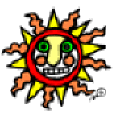En
español 
Classroom website
En
español |
In
1929, Alfonso Marcue, who was the official photographer of the old Basilica of
Guadalupe in Mexico City, found what seemed to be a clear image of a bearded man
reflected in the right eye of the Virgin. Initially he did not believe what was
before his eyes. How could it be? A bearded man inside of the eyes of the
Virgin?. After many inspections of many of his black and white photographs he
had no doubts and decided to inform the authorities of the Basilica. He was told
that time to keep complete silence about the discovery, which he did.
The first one, on March 27, 1956, was Dr. Javier Torroella Bueno, MDS, a prestigious ophthalmologist. In what is the first report on the eyes of the image issued by a physician, he certifies the presence of the triple reflection (Samson-Purkinje effect) characteristic of all live human eyes and states that the resulting images are located exactly where they are supossed to be according to such effect, and also that the distortion of the images agree with the curvature of the cornea. The same year another ophthalmologist, Dr. Rafael Torrija Lavoignet, examined the eyes of the image with an ophthalmoscope in great detail. He observed the apparent human figure in the corneas of both eyes, with the location and distortion of a normal human eye and specially noted a unique appearance of the eyes: they look strangely "alive" when examined. Many other examinations by ophthalmologists have been done of the eyes of the image on the tilma after these first ones. With more or less details all agree with the conclusions of the ones mentioned above.
Dr. Aste Tonsmann published his last studies on the eyes on the tilma in the book "El Secreto de sus Ojos", with complete details and photographs of his work . Perhaps one of the most fascinating aspects of the studies is his conclusion that Our Lady of Guadalupe not only left us her miraculous image as proof of her apparition but some important messages too. These messages were hidden in the eyes on the image until our times, when new technologies would allow them to be discovered, when they are most necessary.  That
would be the case with the image of a family in the center of the Virgin's eye,
in times when families are under serious attack in our modern world. The image
of various human figures that seem to constitute a family, including various
children and a baby carried in the woman's back as used in the 16th century,
appears in the center of the pupil, as shown in this great image of the right
eye highlighting the family, generously provided by Dr. Tonsmann. That
would be the case with the image of a family in the center of the Virgin's eye,
in times when families are under serious attack in our modern world. The image
of various human figures that seem to constitute a family, including various
children and a baby carried in the woman's back as used in the 16th century,
appears in the center of the pupil, as shown in this great image of the right
eye highlighting the family, generously provided by Dr. Tonsmann.
This information comes from: |
¡Gracias por su
visita! home |